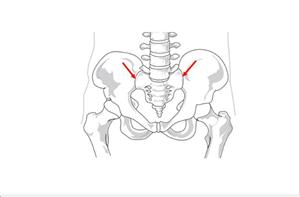Sacroiliac Joint Pain
WHAT IS THE SACROILIAC JOINT?
The sacroiliac joints (SIJs) are structural joints on the left and right side of the pelvis. They are the junction between the sacrum (portion of the tailbone) and the ilium (pelvic bone). The joints have strong weight-bearing properties and therefore, only allow for a small amount of movement, but this movement is crucial for normal biomechanical functioning.
WHAT CAUSES SACROILIAC PAIN?
There are four main factors that may cause SIJ symptoms:·
- TRAUMA: an injury/ fall/ impact to the joint, which can strain the joint, damage the ligaments around the joint and irritate the associated muscular structures
- MECHANICAL: a form of imbalance such as, a leg length discrepancy, mechanical issue of the hip/knee/ankle or adaptive imbalances that can include regularly carrying your child on a specific side or carrying a work bag regularly on one side
- HORMONAL: during pregnancy, the body releases a hormone known as Relaxin, which prepares the pelvic structures mechanically in preparation for giving birth. This can cause laxity of the SIJ ligaments, which can lead to a mechanical cause of SIJ pain
- INFLAMMATORY: certain autoimmune conditions create increased levels on inflammation within the body. If the SIJs are affected, inflammation can negatively affect these joints and associated soft tissues
HOME ADVICE
- Initially, you can apply an icepack directly over the joint area for a maximum of 5- 10 minutes every 2-3 hours. Make sure that the ice is wrapped in a damp cloth/tea towel. The ice has natural anti-inflammatory properties, which can ease symptoms. Do not allow the area to become painfully cold and if you think that the ice is aggravating the symptoms stop immediately
- Avoid the application of heat (e.g. hot water bottles, heat bags, heat patches, heat gels, long hot baths, heated seats in the car). Heat can increase inflammation to a joint area
- Avoid sitting for long periods. Sitting creates excessive compression of the sacroiliac joint. If you job is desk-based, take regular breaks to walk around the workplace. Alternatively, a stand-up desk is advisable
- In bed, lie on your unaffected side with a pillow or rolled up bath towel between your knees. This can reduce pressure on the joint as you sleep.
HOW CAN AN OSTEOPATH HELP?
First, an osteopath will carry out a full examination in order to identify whether the problem is sacroiliac in nature. Hip and lower back issues can mimic sacroiliac pain; therefore, an accurate diagnosis is crucial.
Osteopaths use manual therapy techniques, such as, joint mobilisation, joint manipulation and soft tissue techniques. These methods can help to increase the mobility of the sacroiliac joint, thus, allow for normal joint functioning. Additionally, these techniques can reduce the irritation of the surrounding muscles that commonly contribute to symptoms. We also provide advice that can include home exercises, which can further contribute to your recovery.

